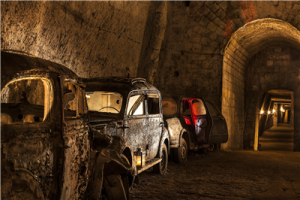The Bourbon Gallery in Naples, on Via Morelli, with 97.5 per cent positive comments, is the most appreciated and admired site in Italy by tourists: this is the result of research by the learning portal Preply, conducted on attractions with at least 1,500 reviews in Italy’s most populous cities.
The Bourbon Gallery the most popular site in Italy
“It is an extraordinary result that I want to share with all the staff, guides and volunteers without whom this achievement would not have been possible. I feel like I am living a dream, this extraordinary result for us and for the city of Naples is a recognition that repays years of sacrifice,’ said geologist Gianluca Minin, President of the Bourbon Underground Association.
Putting together the data and carrying out a detailed analysis based on the opinions expressed by visitors on more than 3,000 places of interest was the Preply platform, the online language learning portal that connects its 32,000 teachers of more than 50 languages with hundreds of thousands of students in more than 180 countries around the world. The site drew up a ranking of the places of interest that proved most disappointing in the eyes of visitors in terms of services offered and ease of use, and ended up awarding the ‘palm’ for the best, which went to the Bourbon Gallery .

In fact, 97.5 per cent of visitors appreciated not only the uniqueness but also the preparation and courtesy of the staff of the best-known attraction in underground Naples, a place full of mysteries, history and fascination. Juliet‘s house in Verona, on the other hand, is Italy’s most disappointing tourist attraction, immediately followed by the amusement park Fiabilandia in Rimini.
The other Preply ranking sites
Positive notes in Preply’s analysis also concern Parma Cathedral (97 per cent consensus) and the Pantheon in Rome (95), which rank ahead of the Colosseum (93) recognised as the attraction with the highest number of visitors in Italy. But the final ranking is drawn up on the basis of negative judgements that place in the ‘top’ places not only the sites already mentioned in Verona and Rimini, but also, for example, the Scalinata di Trinità dei Monti (Spanish Steps), the Rialto Bridge (one of the symbols of Venice), the archaeological park of Neapolis in Syracuse and, to return to things Campania, the Castel Nuovo in Naples, whose visitors said they were disappointed when the visit was over.
The Galleria Borbonica, one of the city’s most fascinating and evocative routes, the pride of Bourbon civil engineering, stretches under the Pizzofalcone hill, near the Royal Palace. It was King Ferdinand II of Bourbon, known as King Bomba, who initiated its construction in 1853. It was needed as a quick escape route, towards the sea, for the royal family in the event of turmoil and as a link to the palace for the troops quartered at the Cavallerizza and Vittoria barracks housed in the Chiaia barracks.
The work was entrusted to the Milanese architect Errico Alvino, who designed a two-lane tunnel with two pavements on either side, connecting the Largo della Reggia (today’s Piazza Plebiscito) to Piazza Vittoria, passing under the Pizzofalcone hill.
Where it is located the gallery and how it is composed
The work lasted three years, and the Bourbon Tunnel was inaugurated on 25 May 1855, with the passage of Ferdinand II, but was only open to the public for three days. The tunnel closed for good due to economic reasons and the decline of the Bourbons with the arrival of the unification of Italy. The work was never completed and stopped, after 431 metres, in the courtyard behind the colonnade in Piazza del Plebiscito.
During the excavations, the network of tunnels and cisterns of the ancient aqueduct built by Cesare Carmignano (1627/29) were found, as well as some tuff caves, such as Carafa’s, used in the 16th century to construct a number of buildings in the area and parts of the route dating back to Greek and Roman times.
In addition, vertical ventilation shafts and a bridge 20 metres long and 10 metres high were built. During the war period, between 1939 and 1945, the Tunnel was used as an air raid shelter, in fact, the rooms were equipped with cots, electricity and cooking utensils to live underground for a few days. Between 5,000 and 10,000 citizens found shelter there, many of whom were left homeless during the bombing of Naples by both the Allies and the Germans.
Later, until the 1970s, it was used as the Municipal Judicial Depot, where everything that had been extracted from the rubble following the bombings was stored, as well as material recovered from collapses, evictions and seizures. Since 2005, the structure has returned to the attention of geologists.

Among the various interventions that have affected the Galleria Borbonica, there is above all the restoration and exhibition of vintage cars and motorbikes found under piles of debris, together with statues from different eras, including the funeral monument of Aurelio Padovani, captain of the Bersaglieri in the First World War.
After various excavation and safety works, the site was opened to the public by the ‘Borbonica Sotterranea’ Cultural Association on 29 October 2010, which, with the support of volunteers, cleared the cavities of accumulated debris, thus creating an underground route of incredible cultural interest.
In September 2013, thanks to ongoing excavation campaigns, a second, larger, multi-level bomb shelter was found. After various works, the access ladder from Palazzo Serra di Cassano was also intercepted. On 30 January 2016, this site was opened to the public.
What are the accessible routes?
The Galleria Borbonica offers four types of route and allows an immersion in two centuries of history by descending 40 metres into tunnels and underground passages:
you can choose between the Standard Route, where you walk inside the Gallery, in the areas of the war shelter and in the aqueduct cisterns, in an evocative journey to discover underground Naples, the Adventure Route, where you can admire 16th and 17th century cisterns and navigate on a raft along the underground watercourse created by the aquifer, the Speleo Route, the longest and most exciting, where, with helmet, suit and harness, one explores the tunnels and cisterns of the ancient underground aqueduct, and the Via delle Memorie, accessible to all, during which one walks among the war shelters.

Some rooms, with their striking tufa walls, can also host theatre, music, dance, art exhibitions or fashion shows. Now an important tourist attraction, the Gallery, also known as the Bourbon Tunnel, has three entrances: one near Piazza del Plebiscito, another near Piazza dei Martiri, on Via Domenico Morelli, and the last at Palazzo Serra di Cassano. This is an excellent opportunity to experience an enthralling, exciting and overwhelming adventure in the Neapolitan underground.


